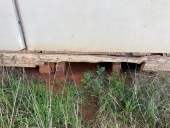


Nancy Reading wrote:
James Dawnung wrote:Conical and Hyperboloid towers seem to be an attractive feature to this end, Especially if built using locally grown materials
Does anyone else but me think that trees might do the same thing?



Doug Kalmer wrote:
There is btw a more easy solution for this, you can get USB solar panels for not too much these days. Plug them in to a honking big USB power bank and you're good to go for between $40-100 depending on how large you want the system to be.Johan Thorbecke wrote:
===========================================================
Do you mean a Uninterrupted Power Supply (UPS)? USB panels are small panels to charge portable devices. I have never heard of a UPS panel, any power source of the right voltage and frequency can charge a UPS. https://www.amazon.com/Computer-Uninterruptible-Power-Supply-Units/b?node=764572

Lito George wrote:Thank you Lauren,
Your Sherlock Holmes hat was fitting perfectly well with that post of yours. The bobbin thread is indeed not catching. So very frustrating at the same time - I'm itching just to have a few stitches go my way ya know?
I'm going to watch some discovered in depth tutorials on thread tension and then find someone who can educate me why the bobbin thread isn't doing its thing. Makes sense now why the original bobbin has been cut with a knife (apparently) and why I had to use a ginger technique in smoothing it all down so that nothing could catch.
I am guessing this machine was neglected or simply never worked well, sat in the basement for a few decades, then was rediscovered after the GrandMa deceased.
I appreciate your feedback and interest and encouragement - its very helpful


Stacy Witscher wrote:I wasn't told to eat wheat everyday for 6 weeks to get tested for celiac. It was the first test the doctor's did, same day as my appointment.
Stacy Witscher wrote:I do agree that IBS triggers are highly individualized. I have to watch the fiber, a moderate amount is good, a large amount is very bad, and a steady supply, about the same amount everyday is best, no ups and downs. And some types of fiber are easier than others.
But other than fiber, I can eat a varied diet, meat, dairy, eggs, wheat etc. I wouldn't want to live without dairy, I would be so unhappy.

Natasha Flue wrote:The thing I've figured out after 3 years is that it is all very individual to the person and how they eat and live. You'll need to experiment and test foods, possibly do an elimination diet.
For me, I never have been diagnosed but I have a cousin with Celiacs and I have always had digestive system issues. Around three years ago I had an esophagus spasm that sent me to the hospital. After that, I went to the doctor and he recommended the FODMAP diet for that and the other issues I'd been having. I started adding foods back in after two months but I need to keep onions, garlic and wheat completely out of my diet.
The other odd thing I noticed is that I need a certain amount of fatty red meat in my diet to not be sick. I had ground venison that I'd been cooking with canola oil and I'd been eating it for months but still had issues. I started eating bacon, saving the fat and cooking the venison in it. Huge difference. I now cook and bake almost all of my own food because it's cheaper and easier than buying stuff in the store. Even things like gluten free granola bars can still make me sick. My grocery store runs now mostly consist of spices, dairy products and rice. I also put away a lot from my garden and local farms.
At the end of the day, you need to sit down, meal plan, track how you feel and what works and doesn't work. Good luck!
